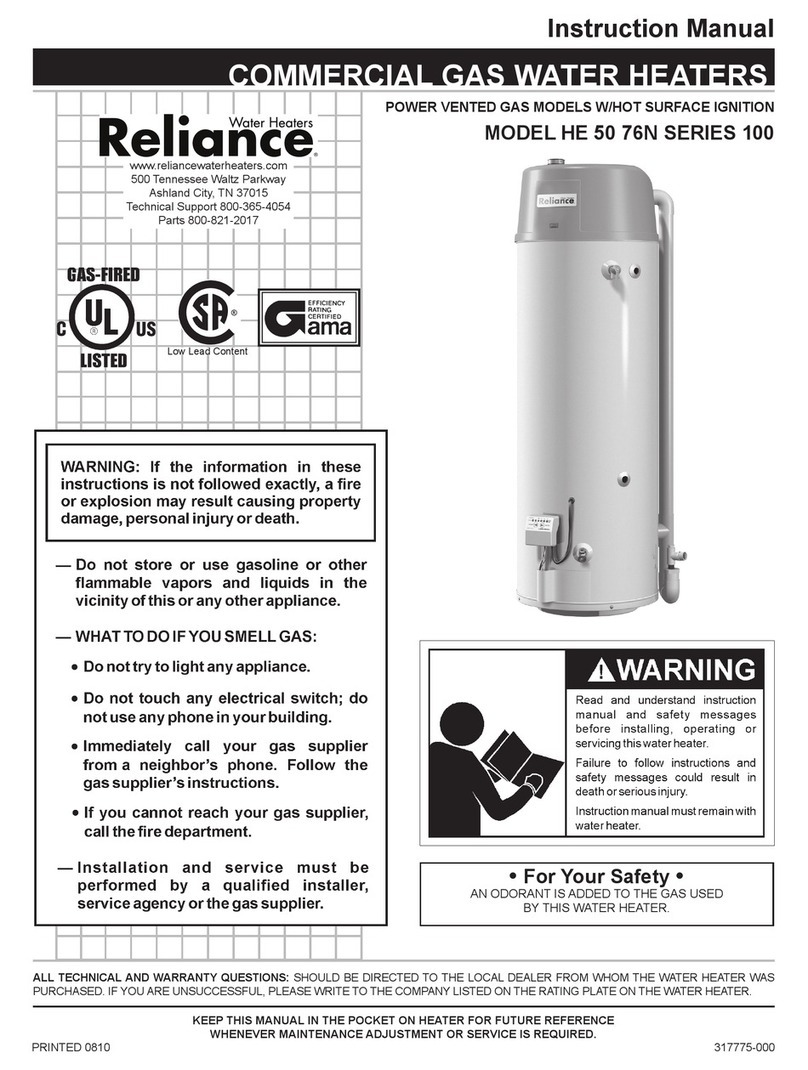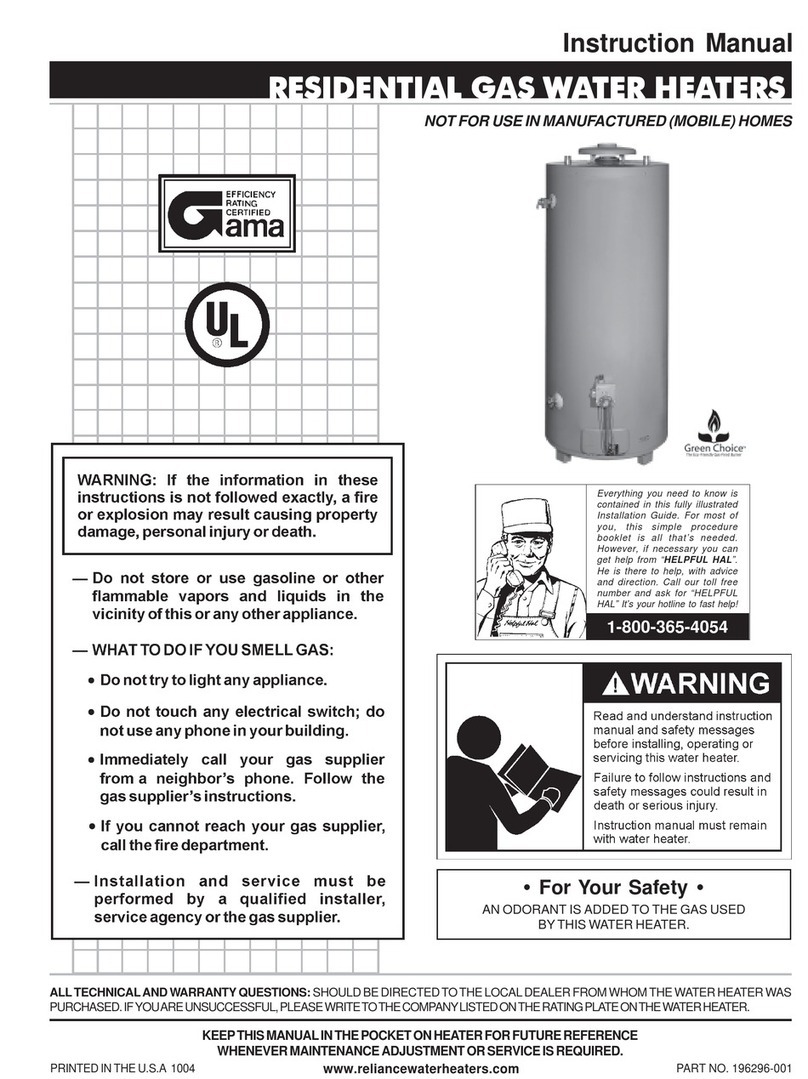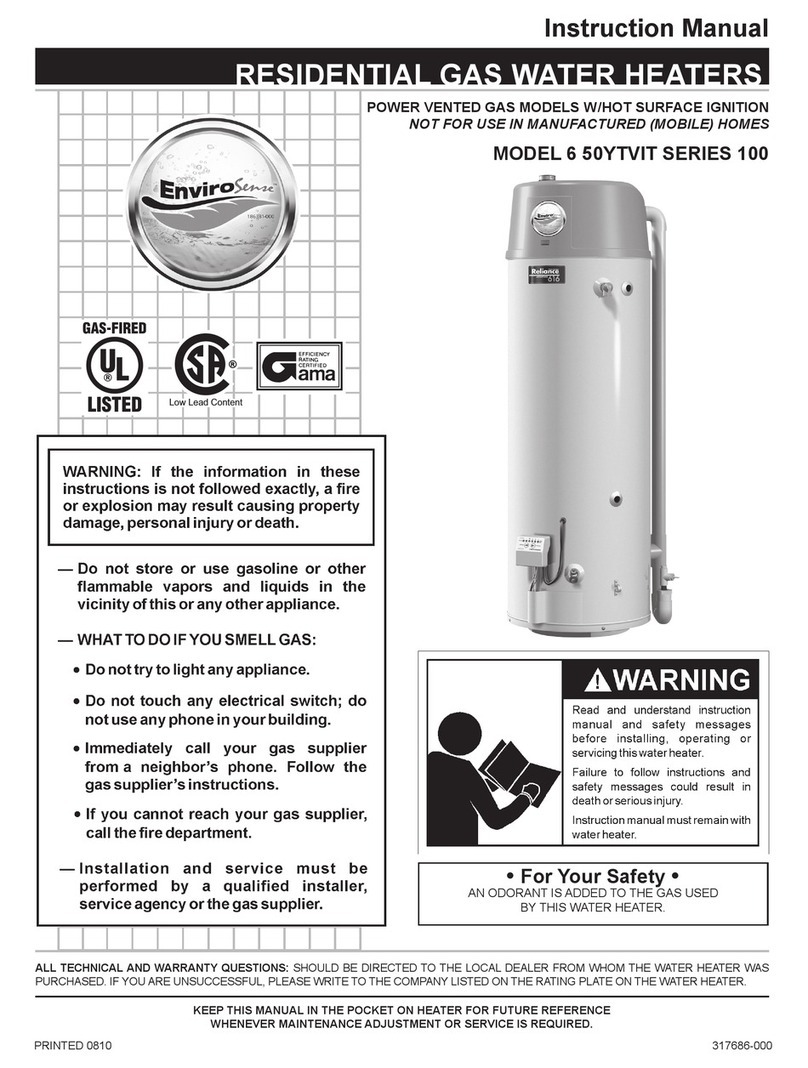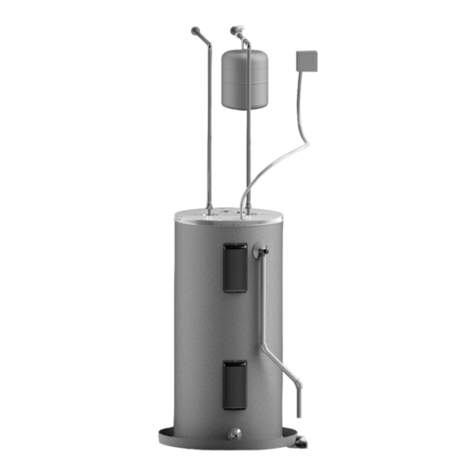
2
WARNING
Improper installation, adjustment, alteration, service or
maintenance can cause DEATH, SERIOUS BODILY INJURY,
OR PROPERTY DAMAGE. Refer to this manual for assistance
or consult the local electric utility for further information.
WARNING
At the time of manufacture this water heater was provided with
a combination temperature-pressure relief valve certified by
a nationally recognized testing laboratory that maintains
periodic inspection of production of listed equipment or
materials, as meeting the requirements for Relief Valves and
Automatic Gas Shut-off Devices for Hot Water Supply Systems,
and the current edition of ANSI Z21.22 • CSA 4.4 and the code
requirements of ASME. If replaced, the valve must meet the
requirements of local codes, but not less than a combination
temperature and pressure relief valve certified as meeting the
requirements for Relief Valves and Automatic Gas Shut-off
Devices for Hot Water Supply Systems, ANSI Z21.22 • CSA 4.4
by a nationally recognized testing laboratory that maintains
periodic inspection of production of listed equipment or
materials.
The valve must be marked with a maximum set pressure not to
exceed the marked hydrostatic working pressure of the water
heater (150 lbs. p.s.i.) and a discharge capacity not less than
the water heater input rate as shown on the model rating plate.
(Electric heaters - watts divided by 1000 x 3412 equal BTU/Hr.
rate.)
Your local jurisdictional authority, while mandating the use of a
temperature-pressure relief valve complying with ANSI Z21.22
• CSA 4.4 and ASME, may require a valve model different from
the one furnished with the water heater.
Compliance with such local requirements must be satisfied
by the installer or end user of the water heater with a locally
prescribed temperature-pressure relief valve installed in the
designated opening in the water heater in place of the factory
furnished valve.
For safe operation of the water heater, the relief valve must not
be removed from it’s designated opening or plugged.
The temperature-pressure relief valve must be installed directly
into the fitting of the water heater designated for the relief valve.
Position the valve downward and provide tubing so that any
discharge will exit only within 6 inches above, or at any distance
below the structural floor. Be certain that no contact is made
with any live electrical part. The discharge opening must not be
blocked or reduced in size under any circumstances. Excessive
length, over 30 feet, or use of more than four elbows can cause
restriction and reduce the discharge capacity of the valve.
No valve or other obstruction is to be placed between the relief
valve and the tank. Do not connect tubing directly to discharge
drain unless a 6" air gap is provided. To prevent bodily injury,
hazard to life, or property damage, the relief valve must be
allowed to discharge water in quantities should circumstances
demand. If the discharge pipe is not connected to a drain or
other suitable means, the water flow may cause property
damage.
The Discharge Pipe:
• Must not be smaller in size than the outlet pipe size of the
valve, or have any reducing couplings or other restrictions.
• Must not be plugged or blocked.
• Must be of material listed for hot water distribution.
• Must be installed so as to allow complete drainage of both
the temperature-pressure relief valve, and the discharge
pipe.
• Must terminate at an adequate drain.
• Must not have any valve between the relief valve and tank.
WARNING
HAZARD OF ELECTRICAL SHOCK! Before removing any
access panels or servicing the water heater, make sure the
electrical supply to the water heater is turned “OFF”. Failure to
do this could result in DEATH, SERIOUS BODILY INJURY, OR
PROPERTY DAMAGE.
WARNING
HOTTER WATER CAN SCALD: Water heaters are intended to
produce hot water. Water heated to a temperature which will
satisfy space heating, clothes washing, dish washing, and
other sanitizing needs can scald and permanently injure you
upon contact. Some people are more likely to be permanently
injured by hot water than others. These include the elderly,
children, the infirm, or physically/mentally handicapped. If
anyone using hot water in your home fits into one of these
groups or if there is a local code or state law requiring a certain
temperature water at the hot water tap, then you must take
special precautions. In addition to using the lowest possible
temperature setting that satisfies your hot water needs, some
type of tempering device, such as a mixing valve, should be
used at the hot water taps used by these people or at the water
heater. Mixing valves are available at plumbing supply or
hardware stores. Follow manufacturers instructions for
installation of the valves. Before changing the factory setting on
the thermostat, read the “Temperature Regulation” section in
this manual.
WARNING
WATER HEATERS EQUIPPED FOR ONE VOLTAGE ONLY: This
water heater is equipped for one type voltage only. Check the
rating plate near the bottom access panel for the correct voltage.
DO NOT use this water heater with any voltage other than the
one shown on the model rating plate. Failure to use the correct
voltage can cause problems which can result in DEATH,
SERIOUS BODILY INJURY, OR PROPERTY DAMAGE. If you
have any questions or doubts consult your electric company.
WARNING
INSULATING JACKETS:When installing an external water
heater insulation jacket on an electric water heater:
a. DO NOT cover the temperature-pressure relief valve.
b. DO NOT put insulation over the access covers or any access
areas.
c. DO NOT remove operating instructions, and safety related
warning labels and materials affixed to the water heater.
d. DO obtain new warning and instruction labels from the
manufacturer for replacement on the blanket directly over
the existing labels.
WARNING
Do not use this appliance if any part of it has been under water.
An electrical short or malfunction could occur. The water heater
should be replaced.
CAUTION
WATER HEATERS EVENTUALLY LEAK: Installation of the water
heater must be accomplished in such a manner that if the tank
or any connections should leak, the flow of water will not cause
damage to the structure. For this reason, it is not advisable to
install the water heater in an attic or upper floor. When such
locations cannot be avoided, a suitable drain pan should be
installed under the water heater. Drain pans are available at
your local hardware store. Such a drain pan must be piped to
an adequate drain.
GENERAL SAFETYGENERAL SAFETY
GENERAL SAFETYGENERAL SAFETY
GENERAL SAFETY




































